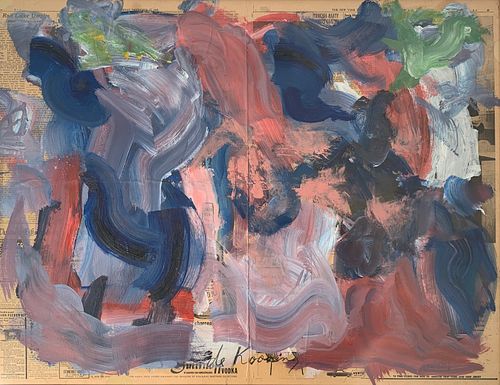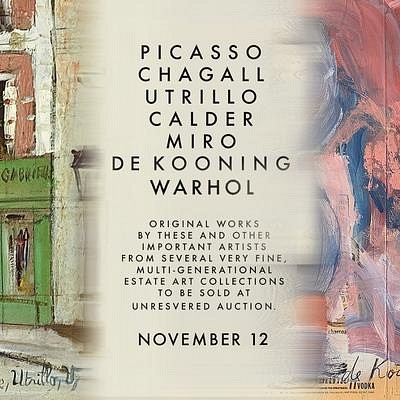Willem de Kooning, Oil Painting on Newspaper
Lot 100
Categories
Estimate:
$150,000 - $200,000
Absentee vs Live bid
Two ways to bid:
- Leave a max absentee bid and the platform will bid on your behalf up to your maximum bid during the live auction.
- Bid live during the auction and your bids will be submitted real-time to the auctioneer.
Bid Increments
| Price | Bid Increment |
|---|---|
| $0 | $25 |
| $300 | $50 |
| $1,000 | $100 |
| $2,000 | $250 |
| $5,000 | $500 |
| $10,000 | $1,000 |
| $20,000 | $2,000 |
| $50,000 | $5,000 |
| $100,000 | $10,000 |
| $200,000 | $25,000 |
| $500,000 | $50,000 |
| $1,000,000 | $100,000 |
About Auction
By Guernsey's
Nov 12, 2022
Set Reminder
2022-11-12 14:00:00
2022-11-12 14:00:00
America/New_York
Bidsquare
Bidsquare : Estate Art Collections
https://www.bidsquare.com/auctions/guernseys/estate-art-collections-11222
Original works by Picasso, Chagall, Renoir, Utrillo, Calder, Miro, De Kooning, Warhol, Haring, and other important artists, multi-generational estate art collections to be sold at unreserved auction. Guernsey's auctions@guernseys.com
Original works by Picasso, Chagall, Renoir, Utrillo, Calder, Miro, De Kooning, Warhol, Haring, and other important artists, multi-generational estate art collections to be sold at unreserved auction. Guernsey's auctions@guernseys.com
- Lot Description
Willem de Kooning (1904-1997)
Untitled
1963
Oil on newspaper mounted on canvas
Signed lower center
22.5 x 29.25 in / 57 x 74,3 cm
Framed: 27 x 39.75 in / 68,5 x 101 cm
Provenance:
Direct from Artist
Gregory Corso
Harvey Guild
Marisa del Re
Gerry Mulligan Foundation
Exhibited:
Marisa de Re Gallery, New York
Born in 1904, Willem de Kooning was a Dutch American abstract expressionist artist. Famous for his Women paintings, de Kooning was often thought to have blended Cubism, Expressionism, and Surrealism as his signature style. Along with painters like Jackson Pollock, Mark Rothko and Franz Kline de Kooning changed the history of modern art, relocating its center from Paris to New York after World War II. de Kooning's pictures typify the vigorous, gestural style of the movement. While many of his colleagues moved from figuration to abstraction, de Kooning always painted figures, most notably women, and abstractions concurrently, making no distinction between the art historical categories. De Kooning's real subject, he insisted, was space and the figure-ground relation.
Like his contemporary Franz Kline, de Kooning used incorporated newspapers into various aspects of his art and art-making process. Expanding upon the newsprint technique he had integrated into his practice since the 1940s, de Kooning began exploring the aesthetic possibilities of what he termed “countertypes” in the mid-1960s. To create works such as Untitled, de Kooning would press large sheets of The New York Times directly onto his freshly-painted canvases – intentionally creating subtle rippling effects before carefully peeling them off. In these works, the immediacy of de Kooning’s painterly gestures collide with the black and white printed words of the newsprint – introducing an element of mass culture into the art world.
One of the most remarkable aspects of de Kooning's career was his ability to move between figurative and abstract modes. De Kooning fused abstraction, figuration, and landscapes in various ways throughout the many long decades of his career, and his unceasing journey to find new forms and subjects made his overall output more eclectic than most of his colleagues. In 1963 de Kooning moved to Springs, Long Island. The women and figures in landscapes from the 1960s, with their lighter colors and fluid brushstroke, were inspired by the light and water that surrounded him on Long Island. The Untitled work offered here is exemplary of de Kooning oeuvre during these years. Noting the date on the New York Times pages that de Kooning used for this work – November 27, 1963 – one can only speculate how and if the assassination of President John F. Kennedy, only five days prior, might have impacted the artist.
Condition/Comment: This work is in very good condition overall. There is minor evidence of wear and handling along the edges and corners, which are obscured by the frame. The newspaper has discolored slightly with age. There is a several small tears from the edges of the artist-mounted newspaper; and two small areas of paper loss – 1 at the upper right corner, and 1 along the bottom edge – neither of which affect the painted image. These condition issues are inherent to the time of execution and the artist’s intent. The colors are bright, fresh and clean. Framed under glass.
This is an online only sale. Items may be viewed upon appointment in New York City.
Notice to bidders: More detailed condition reports and additional photographs are available by request. The absence of a condition report does not imply that the lot is in excellent condition. Please message us through the online bidding platform or call Guernsey's at 212-794-2280 to request a more thorough condition report. Notwithstanding any condition report or discussion concerning a lot, all lots are offered and sold “as is” in accordance with the condition of sale. - Shipping Info
-
Guernsey's does not provide in-house packing and shipping services. Shipping, handling and insurance costs are the responsibility of the winning bidder. Our recommended shipper is a NY-based UPS team that specializes in post-auction shipments, that has been assisting us and our clients for over a dozen years. If you are located in or around New York City and prefer to pick-up your purchase directly from Guernsey's after receiving your paid receipt. Should you wish to learn more about your shipping options, please contact Guernsey's by email at auctions@guernseys.com prior to the auction.
-
- Buyer's Premium



 EUR
EUR CAD
CAD AUD
AUD GBP
GBP MXN
MXN HKD
HKD CNY
CNY MYR
MYR SEK
SEK SGD
SGD CHF
CHF THB
THB




















